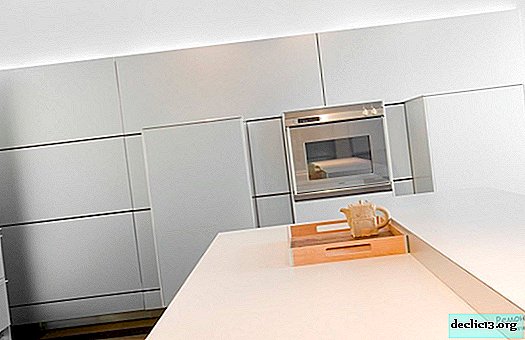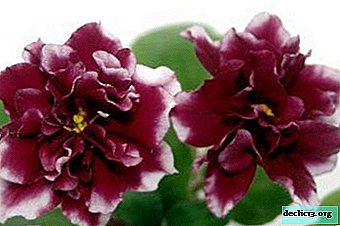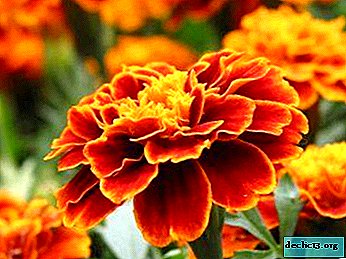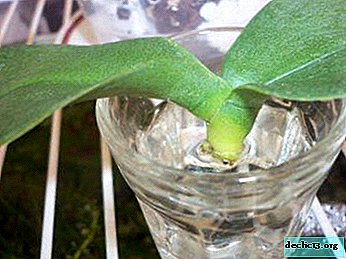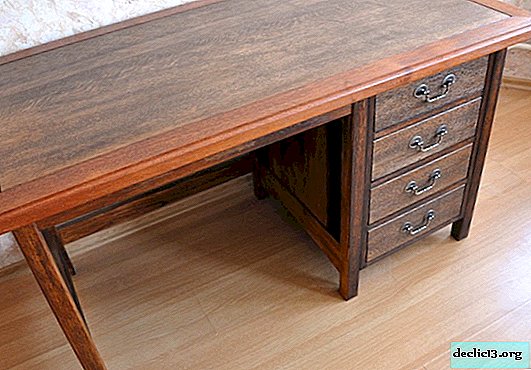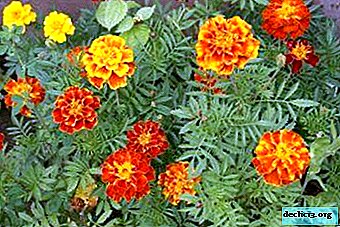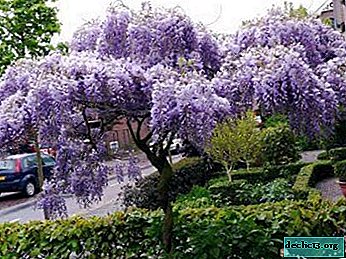A simple way to propagate monophonic sansevieria - leaf
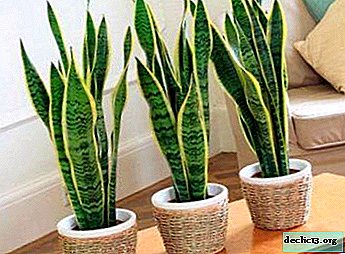
Sansevieria is one of the most famous houseplants not only in our country, but also in the world. People often call her “mother-in-law's tongue”, “pike tail” because of the shape of its leaves.
But not all flower growers know that Sansevieria leaves can be easily propagated.
In the article we will tell. which leaf is better to choose for plant propagation, as well as what nuances should be taken into account when planting the cuttings.
When is it better to propagate sansevier?
Spring is the most favorable time of the year for the reproduction of any plant. Sansevieria is no exception. In the spring, all metabolic processes in it begin to proceed at an accelerated pace, so the rooting process will be faster and more favorable.It should be noted that mother-in-law's tongue is so unpretentious plant that, in principle, it can be successfully propagated at any time of the year. Especially if the reason for the breeding was emergency measures to save the dying Sansevieria: the root system began to rot, the flower fell and broke, etc.
In winter, breeding is not recommended, since it is difficult to provide the new plant with the necessary conditions for its rooting, and metabolic processes are slowed down: the plant will be sick for a long time, it is possible that it will not take root at all.
Soil preparation
 The soil for planting sansevier should be loose, permeable, not heavy. It is best to use a ready-made soil substrate for succulents, bought in a flower shop.
The soil for planting sansevier should be loose, permeable, not heavy. It is best to use a ready-made soil substrate for succulents, bought in a flower shop.
You can prepare the soil mixture for pike tail yourself:
- The composition should include the following components: leaf, turfy soil, humus, sand in a ratio of 2: 2: 1: 1, you can add a little charcoal.
- Another recipe: 4 parts of turf and 2 parts of leafy earth, 1 part of sand are mixed. You can add some organic fertilizers, such as peat, to the composition.
Which pot is suitable?
Material
For sansevieria, a clay or ceramic pot is considered the most suitable. Clay is an environmentally friendly substance, has excellent breathability, thereby providing air access to the roots, absorbs moisture well, as an additional drainage. Clay and ceramic pots are quite stable, and this is an important factor for such a tall plant as mother-in-law's tongue. In addition, clay and ceramic containers are strong, they can withstand the pressure of the powerful roots of sansevieria on the walls.
Attention! The pot must have holes in the bottom to drain excess water, and the bottom of the pot must necessarily cover the drainage layer, which can be used expanded clay, broken brick, pebbles.The size
Mother-in-law's tongue feels most comfortable in small containers: in a cramped position, the plant is more likely to produce flowers.
It’s important that the pot is shallow but wide, as the roots of this plant grow in width.
How to choose a leaf stalk?
A sheet is used from the outlet, which has already bloomed and will not release more new leaves. Most often, the bottom sheet is taken. It should be healthy, without visible damage and flaws.
What nuances should be considered?
 A sheet of sansevieria is cut perpendicular to the veins into pieces of 5-15 cm each. It is necessary to note or remember where each fragment has the top and where the bottom. When rooting, immerse the stalk in water or soil should only be the lower part, taking into account the direction of movement of the plant juices. If this nuance is not taken into account, then the stem will not give roots.
A sheet of sansevieria is cut perpendicular to the veins into pieces of 5-15 cm each. It is necessary to note or remember where each fragment has the top and where the bottom. When rooting, immerse the stalk in water or soil should only be the lower part, taking into account the direction of movement of the plant juices. If this nuance is not taken into account, then the stem will not give roots.
The number of cut leaves depends on how many copies of young plants you need to get. A larger number of leaves increases the likelihood that the product of the cuttings will succeed: if even some petioles do not take root, the bulk will still start the roots.
Landing at home in the water
- Prepare everything you need: a container of water, sharp scissors, a sheet of sansevieria, the drug "Kornevin."
- Cut the sheet into several fragments, mark the top and bottom of each segment (you can use a simple ballpoint pen).
- In the container (preferably transparent for better monitoring the state of the produced roots) with water add a little preparation "Kornevin."
- Each of the petioles of a pike tail should be lowered into water, strictly following the rule: only the lower part is immersed in the liquid.
- After each of the fragments has driven out the roots, they should be planted in pots with soil.
How to plant in the ground?
- Prepare all the tools and what will be necessary when planting: a container (preferably flat and wide), soil (perlite, sand), Kornevin, a spatula, scissors, a watering can with water (about what should be the soil for sansevieria, we talked here).
- Cut the sheet into several parts, mark the top and bottom of each segment (you can use a simple ballpoint pen).
- The resulting cuttings should be slightly dried for several hours.
- Pay attention to the fragments, strictly follow the basic rule: the lower part of the handle is buried in the ground.
- Each lower part of the fragments should be treated with Kornevin.
- Pour sand or other filler into the container, make grooves in it about 3 cm long.
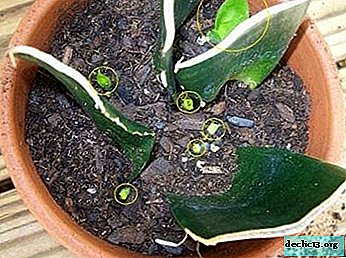 In each of the grooves, plant cuttings by deepening each at an angle of 45 degrees by a third (planting depth - about 1.5 - 2 cm). The distance between the cuttings is 2 - 3cm.
In each of the grooves, plant cuttings by deepening each at an angle of 45 degrees by a third (planting depth - about 1.5 - 2 cm). The distance between the cuttings is 2 - 3cm.- To protect against diseases, cuttings need to be sprayed with fungicide (which diseases and pests can destroy sansevieria and how to help the affected plant, read here).
- As soon as the roots appear, the plant should be transplanted into an individual pot with soil (read more about the rules for transplanting sansevieria here).
Rooting usually occurs after 1.5 to 2 months. And after 7-8 months, the sansevieria planted in the ground will give new young shoots.
It is undesirable to make a greenhouse, since increased humidity in it can contribute to decay of cuttings.
Relocation of pike tail in warm time to a flower bed
Sansevieria feels comfortable in the open ground. It grows well in the sun and in the shade, does not require frequent transplantation, tolerates drafts, rare and even very rare watering. Some flower growers specially, the threat of spring frosts barely disappears, they transplant the plant into a flower bed so that it "heals" there: the leaves gained strength, the color became brighter, and finally the flower stalk was released.
How to do it:
- Slightly dig up the earth in the flowerbed, thereby saturating it with oxygen. You can add a little sand, peat, humus to the soil.
- Dig a hole in the ground, the depth of which will correspond to the height of the pot in which sansevieria grew.
- Pour the hole and flower in the pot.
- Carefully remove the plant along with the earthen lump and, without shaking off the substrate, transfer it to the hole.
- Cover the remaining voids with soil, taking it a little.
- During the summer, it is systematically necessary to loosen the soil around the pike tail, to fertilize, to water - as the top layer of the soil dries.
- As soon as the onset of autumn the temperature drops to + 17C - + 18C, the plant must be watered abundantly.
- Carefully dig sansevieria from the ground: most likely, the root system has grown rapidly over the summer, so you will need to transplant the flower into a larger pot.
- Planting in a pot is carried out in the usual way.
- The flower in the pot is first brought to the veranda or balcony, and after 3 days to the apartment or house.
Photo
Look how beautiful the pike tail looks on the flowerbed:



Care for young cuttings
If the reproduction of sansevieria was carried out by dividing the leaf, then after immersing the cuttings in the soil, they need to be watered (for details on the methods of reproduction of the pike tail, see here). Then it is necessary to water future plants sparingly, bearing in mind that mother-in-law's tongue is succulent. Recommended temperature for keeping the container with petioles is + 20C - + 22C. It is at this temperature that rooting is faster and more efficient. Sansevieria loves a lot of diffused light, but direct sunlight should be avoided on the petioles.
What to do if the plant does not take root?
Despite the fact that Sansevier is very unpretentious in leaving, still sometimes rooted segments do not take root. What is the reason? As a rule, excessive watering is guilty of this, as a result of which the tip of the stalk may rot after planting. You can try to correct the situation by doing the following: get the stalk from the ground, cut off the decayed tip, wither it in the open air, treat it with “Kornevin” and root again. You should also adjust the irrigation scheme so that a similar situation does not happen again.
Even a beginner grower can propagate a favorite plant in this way. But it is important not to forget about proper care for sansevieria, so that for more than one year young and old plants adorned the interior of the apartment or the design of the flowerbed with their original form.

 In each of the grooves, plant cuttings by deepening each at an angle of 45 degrees by a third (planting depth - about 1.5 - 2 cm). The distance between the cuttings is 2 - 3cm.
In each of the grooves, plant cuttings by deepening each at an angle of 45 degrees by a third (planting depth - about 1.5 - 2 cm). The distance between the cuttings is 2 - 3cm.